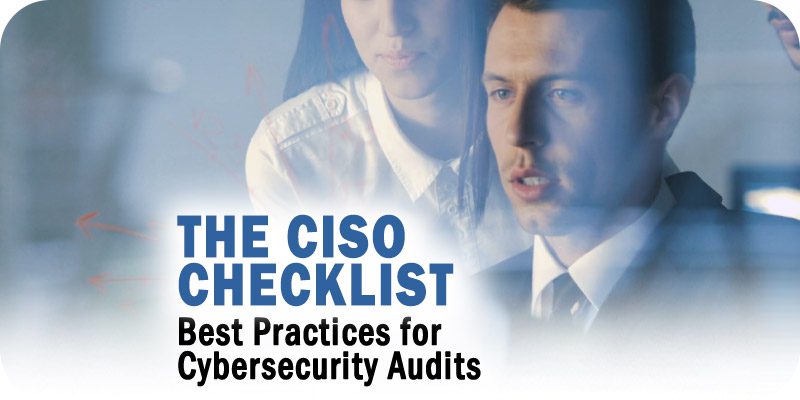The CISO Checklist and Best Practices for Conducting a Cybersecurity Audit


Solutions Review’s Expert Insights Series is a collection of contributed articles written by industry experts in enterprise software categories. Taylor Hersom of Eden Data works down a checklist for conducting a cybersecurity audit while providing some best practices to consider.
 A cybersecurity audit is something that many organizations will put off for a long time. However, whether you like it or not, they must be done at some point, especially with zero-trust frameworks becoming ever-present and cyber-criminals stepping up their hacking efforts. According to a recent PWC survey, CEOs ranked cybersecurity risks as their biggest concern, even more so than the ongoing Covid-19 pandemic, economic recession, or climate change. CISOs must be prepared to conduct cybersecurity audits and regular intervals to ensure that various security measures and protocols are followed while also identifying potential weaknesses.
A cybersecurity audit is something that many organizations will put off for a long time. However, whether you like it or not, they must be done at some point, especially with zero-trust frameworks becoming ever-present and cyber-criminals stepping up their hacking efforts. According to a recent PWC survey, CEOs ranked cybersecurity risks as their biggest concern, even more so than the ongoing Covid-19 pandemic, economic recession, or climate change. CISOs must be prepared to conduct cybersecurity audits and regular intervals to ensure that various security measures and protocols are followed while also identifying potential weaknesses.
Primarily, organizations conduct cybersecurity audits to get insights into the most critical datasets and how they should be protected. It helps you understand all the risks facing your company. It allows the CEO and CISO to develop a strategy to improve the IT department and broader team’s capabilities to confront a cyber-attack. Aside from identifying risks, a cybersecurity audit — externally or internally — will also give you plenty of other benefits. These may include reassuring your clients about data safety, improving cybersecurity procedures, and generally raising awareness about cybersecurity for your staff.
Let’s dive into what CISOs need to know, whether they are conducting a cybersecurity audit or being audited externally.
Widget not in any sidebars
The Cybersecurity Audit Checklist
The Initial Steps
One of the first steps for any CISO checklist should be to review the organization’s existing cybersecurity procedures and policies. This involves seeing what gaps may exist or need to be updated while bearing in mind that third-party service vendors must follow the same policies. Common policies include remote access, incident response, communication, and access control.
Prior to initiating a cybersecurity audit, it is essential to review your compliance demands. These regulations and guidelines may fluctuate depending on the geographic area. If being audited externally, your auditors require the full particulars of your compliance. If your information needs to be updated, they will provide an overview to guarantee that your operations abide by any industry regulations you are subject to.
Technical Infrastructure and Network Diagrams
The next move should be for the CISO to inspect the technical structure of the organization. This entails examining the network design, safety measures, and any hardware or software employed. The CISO should also gauge the efficiency of the organization’s security monitoring and logging systems and any intrusion detection and prevention systems. The purpose of this step is to determine any potential security risks that could be taken advantage of by malicious actors.
A logical network diagram illustrates the way in which information is transmitted across a network, featuring elements like subnets, domains, devices, network segments, routers, and other applicable network entities. On the other hand, a physical network diagram displays the tangible components of the network, such as servers, ports, cables, racks, and other pertinent hardware. Both are vital during a cybersecurity audit.
Data and Response
The fourth step should be to assess the organization’s data security measures. This includes evaluating the data classification system and ensuring that all sensitive data is stored securely and encrypted. Additionally, the CISO should assess the organization’s backup and disaster recovery plans to ensure that data can be recovered in the event of a security breach or other disaster.
Once the cybersecurity audit is complete, you can use the improved sense of priority to determine what to do next. This audit will pinpoint which areas of your network are more vulnerable and provide possible solutions to these problems. By focusing on the most pressing threats, you will have peace of mind knowing your business’s data is secure and can avoid potential cyber-attacks.
A final checklist to make sure you miss nothing
- A list of all the hardware owned by the company
- A record of all the software used by the organization
- Measures for continued vulnerability management
- Measures for controlling access to administrative rights
- Settings for security on hardware and software across all devices, like laptops, computers, servers, and phones
- Maintenance and surveillance timetables, as well as audit reports
- Protection from email and browser threats
- Protection from malicious software
- Regulated access to network ports, including all protocols and server information.
Final Thoughts on the Importance of the Cybersecurity Audit
As a business owner, you must be aware of all the potential dangers and risks. Malicious actors can target your system, and cybersecurity audits are the best way to learn about your system’s vulnerabilities. Regular audits can boost the security of your information and increase customer and business partner trust.
Security audits also review your data and operational processes, pinpointing any weaknesses in your network and infrastructure. Audit results provide detailed reports of what needs to be improved and updated while assessing your assets to ensure your security processes function correctly and make necessary corrections.
Widget not in any sidebars



















